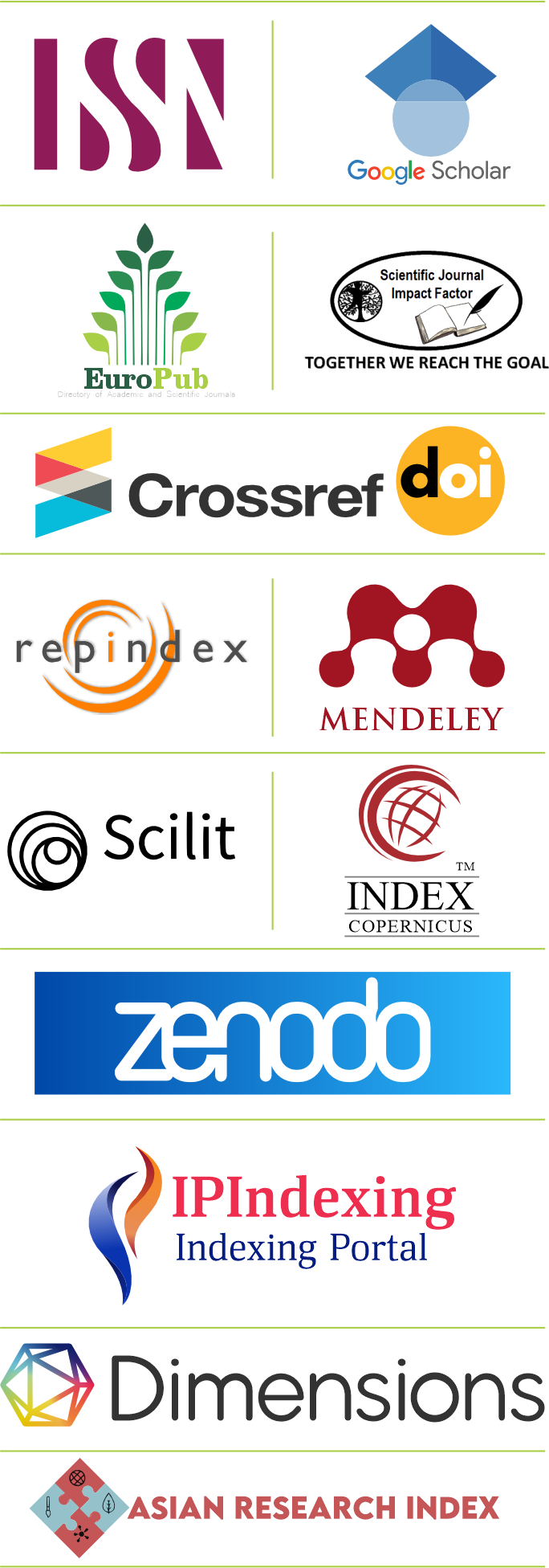Population Growth and Climate Change: Implications for Human Development in Pakistan
DOI:
https://doi.org/10.55737/qjssh.122337966Keywords:
Human Development, Population Growth, Climate Change, PakistanAbstract
The study examines how population growth and climate change affect human development in Pakistan. The rapid population growth and escalating climate change impacts in the country necessitate an understanding of their implications for human development. The study utilized time series data from 1990 to 2020 and employed descriptive analysis, an Autoregressive distributed lag (ARDL) model, a unit root test, and a bounds test for cointegration to analyze the data. The study considered the variables for analysis, such as Human Development, Climate change, and Population growth. The findings revealed that population growth and climate change have significantly influenced human development outcomes in Pakistan, with higher population growth and climate change leading to lower human development levels in the long run. The implications of the study underscored the need for urgent action to address the negative impacts of rapid population growth and climate change on human development in Pakistan. The study derived several suggestions from the findings, including implementing a family planning program, investing in education, promoting climate change awareness campaigns, integrating climate change considerations into national policies, empowering local communities, and encouraging research and innovations in sustainable development and climate change adaptation.
References
Abdulkadir, A., Lawal, A. M., & Muhammad, T. (2018). Climate change and its implications on human existence in Nigeria: a review. Bayero Journal of Pure and Applied Sciences, 10(2), 152. https://doi.org/10.4314/bajopas.v10i2.26
Adeosun, O. T., & Popogbe, O. O. (2020). Population growth and human resource utilization nexus in Nigeria. Journal of Humanities and Applied Social Sciences, 3(4), 281–298. https://doi.org/10.1108/jhass-06-2020-0088
Adikari, A. P., Liu, H., Dissanayake, D., & Ranagalage, M. (2023). Human Capital and Carbon Emissions: The Way forward Reducing Environmental Degradation. Sustainability, 15(4), 2926. https://doi.org/10.3390/su15042926
Amin, R. (2022). Population growth and literacy Rate in Assam: A comparative study. ResearchGate. https://www.researchgate.net/publication/361306494_Population_Growth_and_Literacy_Rate_in_Assam_A_Comparative_Study
Andaiyani, A. (2013). The effect of the Human Development Index, economic growth, and operational expenditure on the amount of capital expenditure allocation in district/city governments in West Kalimantan Province. Regional Economic Journal, 1.
Arab, M., Damankeshideh, M., Jafari Samimi, A., Daghighiasli, A., & Esmailzadeh Maghari, A. (2022). Human development and environmental sustainability in oil exporting countries. International Journal of Business and Development Studies, 14(1), 5–23. https://doi.org/10.22111/ijbds.2022.7435
Çakar, N. D., Gedikli, A., Erdoğan, S., & Yıldırım, D. Ç. (2021). Exploring the nexus between human capital and environmental degradation: The case of EU countries. Journal of Environmental Management, 295, 113057. https://doi.org/10.1016/j.jenvman.2021.113057
Chandram, V. K. P. (2015). Impact of climate change on human development in India: Identifying links and need for adaptation strategies. Artha Journal of Social Sciences, 14(4), 111. https://doi.org/10.12724/ajss.35.6
Chaudhry, Q. U. Z. (2017). Climate change profile of Pakistan. https://doi.org/10.22617/tcs178761
Chaudhry, Q. U. Z., Mahmood, A., Rasul, G., & Afzaal, M. (2009). Climate change indicators of pakistan. Pakistan Meteorological Department. Islamabad. Technical Report No. PMD-22/2009: 1-43. https://shorturl.at/ekvHT
Chauhan, R., & Mukherjee, S. (2019). Population growth and human development: evidence from Asian countries. International Journal of Social Economics, 12, 1498-1514.
Chen, F., & Lu, J. (2012). Population growth and human development: An empirical analysis. Journal of Human Development and Capabilities, 13, 65-81.
Costello, A., Abbas, M. M. E., Allen, A., Ball, S., Bell, S., Bellamy, R., Friel, S., Groce, N., Johnson, A. M., Kett, M., Lee, M., Levy, C., Maslin, M., McCoy, D., McGuire, B., Montgomery, H., Napier, D., Pagel, C., Patel, J., . . . Patterson, C. (2009). Managing the health effects of climate change. The Lancet, 373(9676), 1693–1733. https://doi.org/10.1016/s0140-6736(09)60935-1
Damanik, D., Purba, E., & Hutabarat, N. a. S. (2021). The Effect of Population and Human Development Index on Economic Growth Pematangsiantar City. Budapest International Research and Critics Institute (BIRCI-Journal): Humanities and Social Sciences, 4(3), 3658–3668. https://doi.org/10.33258/birci.v4i3.2134
Desriandra, I., & Murialti, N. (2016). Analysis of factors influencing the Human Development Index in Riau Province. Journal of Accounting and Economics, 6, 98-107.
FAO. (2022). Food and Agriculture Statistics. Annual Surface Temperature Change. https://www.fao.org/food-agriculture-statistics/data-release/data-release-detail/en/c/1492093/
Ferjan, I. (2014). Holistic measurement of quality of life: Human Development Index. Economics - Innovative and Economics Research Journal, 2(1). https://doi.org/10.7251/oik1402006f
GOP. (2022). Pakistan Economic Survey 2021-22. Finance and Economic Affairs Division, Ministry of Finance, Govt. of Pakistan, Islamabad, Pakistan. https://www.finance.gov.pk/survey/chapter_22/Highlights.pdf
GOP. (2023). Pakistan Economic Survey 2022-23. Finance and Economic Affairs Division, Ministry of Finance, Govt. of Pakistan, Islamabad, Pakistan. https://www.finance.gov.pk/survey/chapters_23/Overview_of_the_Economy.pdf
Güney, T. (2017). Population growth and sustainable development in developed developing countries: AN IV (2SLS) Approach Population Growth and Sustainable Development In Developed-Developing Countries: AN IV (2SLS) approach. Population, 22(4), 1255-1277. https://iibfdergi.sdu.edu.tr/assets/uploads/sites/352/files/yil-2017-cilt-22-sayi-4-yazi20-04122017.pdf
Hao, Y. (2022). Effect of economic indicators, renewable energy consumption and human development on climate change: an empirical analysis based on panel data of selected countries. Frontiers in Energy Research, 10. https://doi.org/10.3389/fenrg.2022.841497
Hart, C. (1990). The making of the human development report. 13-14.
Herrero, C., Del Olmo Martínez, R., & Villar, A. (2018). Population structure and the Human Development Index. Social Indicators Research, 141(2), 731–763. https://doi.org/10.1007/s11205-018-1852-0
Hossain, M. A., & Chen, S. (2021). Nexus between Human Development Index (HDI) and CO2 emissions in a developing country: decoupling study evidence from Bangladesh. Environmental Science and Pollution Research, 28(41), 58742–58754. https://doi.org/10.1007/s11356-021-14822-5
IMF. (2022). Climate Change Indicators Dashboard. Annual Surface Temperature Change. https://climatedata.imf.org/pages/access-data
IPCC. (2022). Annex I: Glossary. In: Intergovernmental Panel On Climate, C. (ed.) Global Warming of 1.5°C: IPCC Special Report on Impacts of Global Warming of 1.5°C above Pre-industrial Levels in Context of Strengthening Response to Climate Change, Sustainable Development, and Efforts to Eradicate Poverty. Cambridge: Cambridge University Press. https://doi.org/10.1017/9781009157940
IPCC. (2023). Climate Change 2023 Synthesis Report Summary for Policymakers. Synthesis Report (SYR) of the IPCC Sixth Assessment Report. https://www.ipcc.ch/report/ar6/syr/downloads/report/IPCC_AR6_SYR_SPM.pdf
Javaid, A., Akbar, A., & Nawaz, S. (2018). A review on Human Development Index. Pakistan Journal of Humanities and Social Sciences, 6(3), 357-369. https://ssrn.com/abstract=3432413
Johnston, D.F. (1988). Toward a comprehensive ‘quality-of-life’index. Social indicators research, 20, 473-496. https://doi.org/10.1007/BF03359553
Kewalani, R., & Saifudeen, I. S. H. (2021). Exploring Human Longevity: The Impact of Climate on Life Expectancy. https://doi.org/10.36838/v3i3.7
Lai, S. L., & Chen, D. N. (2020). A research on the relationship between environmental sustainability management and human development. Sustainability, 12(21), 9001. https://doi.org/10.3390/su12219001
Lind, N. C. (1992). Some thoughts on the Human Development Index. Social Indicators Research, 27, 89-101. https://doi.org/10.1007/BF00300511
Maccari, N. (2014). Environmental sustainability and human development: a greening of Human Development Index. Available at SSRN 2426073. https://dx.doi.org/10.2139/ssrn.2426073
Meehl, G. A., & Tebaldi, C. (2004). More intense, more frequent, and longer lasting heat waves in the 21st century. Science, 305(5686), 994-997. https://doi.org/10.1126/science.1098704
Muslikhati, M. (2018). Causality Analysis of Economic Growth on the Human Development Index. Falah: Journal of Islamic Economics, 3, 71-83.
Ngalande-Banda, T. (2017). Population growth and human development in Sub-Saharan Africa. Journal of African Studies and Development. 1, 1-10.
NOAA. (2022). Monthly Global Climate Report for Annual 2022. https://www.ncei.noaa.gov/access/monitoring/monthly-report/global/202213
Ochinyabo, S. (2021). Rapid population growth and economic development issues in Nigeria. Journal of Economics and Allied Research. 6, 1-13. https://jearecons.com/index.php/jearecons/article/view/155
Opoku, E. E. O., Dogah, K. E., & Aluko, O. A. (2022). The contribution of human development towards environmental sustainability. Energy Economics, 106, 105782. https://doi.org/10.1016/j.eneco.2021.105782
PAHO. (2015). Basic Indicators Glossary. Health Information and Analysis Unit (HA). Washington DC. https://www.paho.org/hq/dmdocuments/2015/glossary-eng-2014.pdf
Pesaran, M. H., & Pesaran, B. (1997). Working with Microfit 4.0: Interactive econometric analysis. Oxford University Press. https://cir.nii.ac.jp/crid/1130282270030044416
Pesaran, M. H., & Shin, Y. (1995). An autoregressive distributed lag modelling approach to cointegration analysis (Vol. 9514). Cambridge, UK: Department of Applied Economics, University of Cambridge. http://dx.doi.org/10.1017/CCOL0521633230.011
Potter, R. B., Binns, T., & Elliott, J. A. (2008). Geographies of development: An introduction to development studies. Pearson Education. https://doi.org/10.4324/9781315759319
Pradana, F. A. (2019). Human development analysis: the role of demographic factors in West Nusa Tenggara in the period of 2013-2017. Jurnal Ilmiah Mahasiswa, 7(2). http://repository.ub.ac.id/id/eprint/174627
Purba, B. S., Arfandi, E., Purba, S., Sitorus, P.D., Panjaitan, D., Damanik, M.I.A., Lubis, M., Maisyarah, M.F., Rahmadana & Khairad, F. (2021). Ekonomi Demografi, Yayasan Kita Menulis. https://doi.org/10.59107/ri.v1i1.21
Rahman, M. R., & Lateh, H. (2017). Climate change in Bangladesh: a spatio-temporal analysis and simulation of recent temperature and rainfall data using GIS and time series analysis model. Theoretical and applied climatology, 128, 27-41. https://doi.org/10.1007/s00704-015-1688-3
Rauf, S., Bakhsh, K., Abbas, A., Hassan, S., Ali, A., & Kächele, H. (2017). How hard they hit? Perception, adaptation and public health implications of heat waves in urban and peri-urban Pakistan. Environmental Science and pollution research, 24, 10630-10639. https://doi.org/10.1007/s11356-017-8756-4
Saghir, J., & Santoro, J. (2018, April). Urbanization in Sub-Saharan Africa. In Meeting Challenges by Bridging Stakeholders. Washington, DC, USA: Center for Strategic & International Studies. https://www.jstor.org/stable/pdf/resrep22454.pdf
Selén, J. (1985). Multidimensional descriptions of social indicators. Social Indicators Research, 17, 435-445. https://doi.org/10.1007/BF00290324
Sen, A. K. (1987). Commodities and capabilities: Professor Dr. P. Hennipman lectures in economics, 1982 delivered at the University of Amsterdam. Oxford University Press. https://shorturl.at/gvJO0
Shahvari, N., Khalilian, S., Mosavi, S. H., & Mortazavi, S. A. (2019). Assessing climate change impacts on water resources and crop yield: a case study of Varamin plain basin, Iran. Environmental monitoring and assessment, 191, 1-12. https://doi.org/10.1007/s10661-019-7266-x
Sheykhi, M. T. (2021). Population and development vs quality of life: a sociological appraisal. Middle East. https://platform.almanhal.com/Files/Articles/246052
Sibly, R. M., & Hone, J. (2002). Population growth rate and its determinants: an overview. Philosophical Transactions of the Royal Society of London. Series B: Biological Sciences, 357(1425), 1153-1170. https://doi.org/10.1098/rstb.2002.1117
Stewart, F. (2013). Capabilities and Human Development: Beyond the individual-the critical role of social institutions and social competencies. UNDP-HDRO occasional papers, (2013/03). https://ssrn.com/abstract=2344469
Tolba, M. K. (1992). Population growth and human development: Saving our planet: challenges and hopes. Springer Science & Business Media. https://doi.org/10.1007/978-94-011-2278-8_16
Ul Haq, M. (1995). Reflections on human development. oxford university Press. https://shorturl.at/eMNYZ
Ullah, W., Nafees, M., Khurshid, M., & Nihei, T. (2019). Assessing farmers’ perspectives on climate change for effective farm-level adaptation measures in Khyber Pakhtunkhwa, Pakistan. Environmental monitoring and assessment, 191, 1-18. https://doi.org/10.1007/s10661-019-7651-5
UN. (1992). The United Nations Framework Convention On Climate Change (UNFCCC).
UN. (1993). Climate Action. https://www.un.org/en/climatechange/what-is-climate-change
UNDESA. (2004). Demographic dynamics and sustainability. Division for Sustainable Development. UN Department of Economic and Social Affairs. https://www.un.org/esa/sustdev/natlinfo/indicators/indisd/english/chapt5e.htm
UNDESA. (2022). Population Division. World Population Prospects 2022: Summary of Results. UN DESA/POP/2022/TR/NO. 3.
UNDP. (2015). What is Human Development? https://hdr.undp.org/content/what-human-development
UNDP. (2020). Pakistan National Human Development Report 2020. United Nations Development Programme, Pakistan.
UNDP. (2022a). HDR Technical Notes 2021-22. United Nations Development Programme. https://hdr.undp.org/sites/default/files/2021-22_HDR/hdr2021-22_technical_notes.pdf
UNDP. (2022b). Human Development Report 2021-22. United Nations Development Programme. http://report.hdr.undp.org
UNDP. (2023a). Human Development Index (HDI). https://hdr.undp.org/data-center/human-development-index#/indicies/HDI
UNDP. (2023b). The Climate Dictionary: An everyday guide to climate change. https://climatepromise.undp.org/news-and-stories/climate-dictionary-everyday-guide-climate-change
Weeks, J. R. (2020). Population: An introduction to concepts and issues. Cengage Learning. https://shorturl.at/hsuB1
WHO. (2023). The Global Health Observatory. World Health Organization. https://www.who.int/data/gho/indicator-metadata-registry/imr-details/1120
Williamson, J. G., & Fisk, M. (2006). Population growth, education, and human capital: A simulation analysis. In R. E. B. Lucas (Ed.), International handbook on migration and economic development. Edward Elgar Publishing, 323-350.
World Bank. (2021). What is Climate Change?. Climate Change Knowledge Portal. https://climateknowledgeportal.worldbank.org/overview
Zahonogo, P. (2016). Trade and economic growth in developing countries: Evidence from sub-Saharan Africa. Journal of African Trade, 3(1-2), 41-56. https://doi.org/10.1016/j.joat.2017.02.001
Zhongming, Z., Linong, L., Xiaona, Y., Wangqiang, Z., & Wei, L. (2017). Climate Change Profile of Pakistan. https://dx.doi.org/10.22617/TCS178761
Published
Issue
Section
License
Copyright (c) 2023 Kainat Batool, Izhar Ahmad Khan, Naveed Farah, Muhammad Hassan Safdar, Najaf Hussain

This work is licensed under a Creative Commons Attribution-NonCommercial 4.0 International License.





